The Red Envelope: Billkin and PP Krit’s Take on a Love Story Beyond the Grave
In a cinematic landscape saturated with remakes, reboots and sequels, you might ...
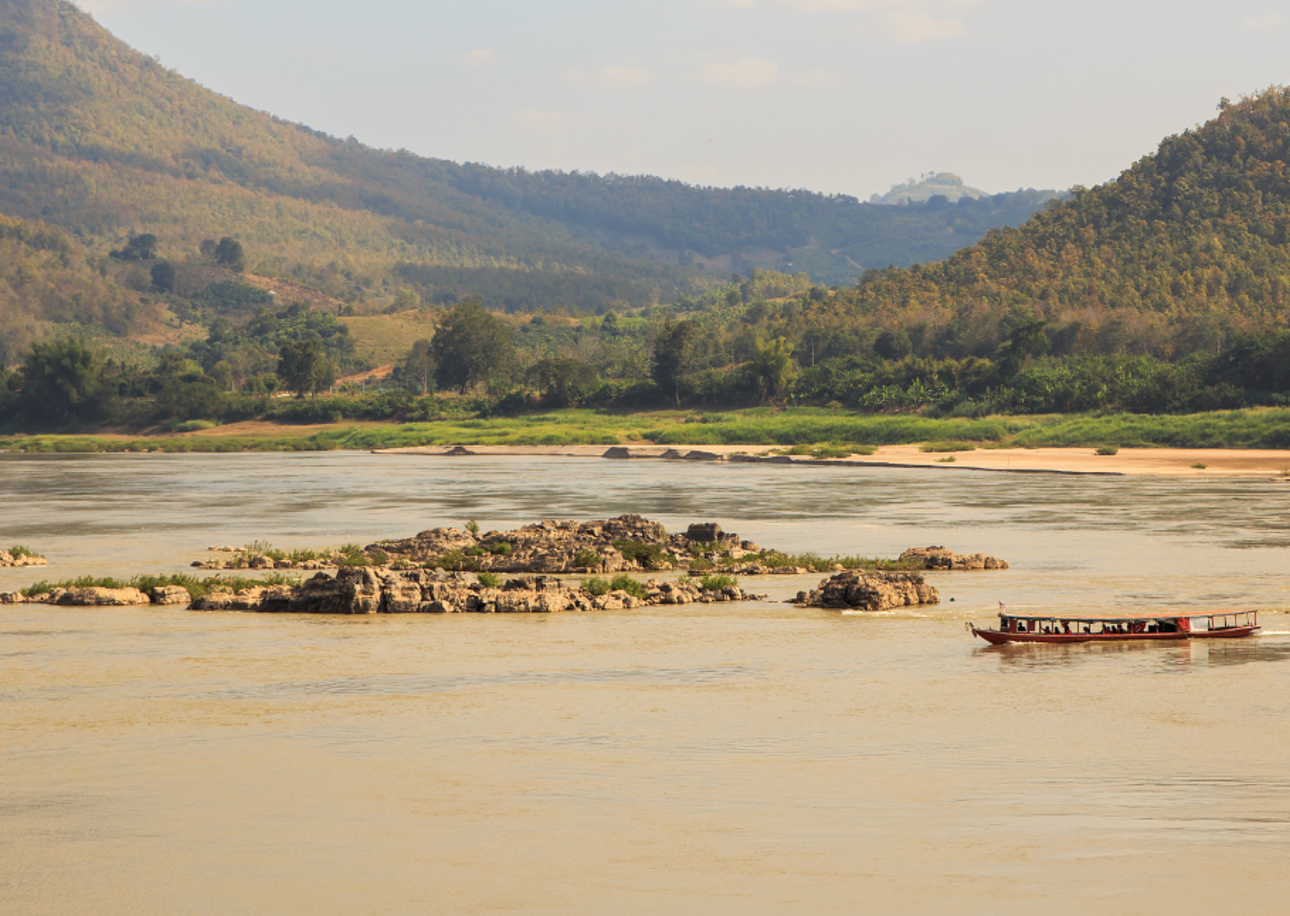
In the mid 1990’s I was involved in the publication of a coffee table book titled the Mighty Mekong. It was written by John Hoskins and photographed by his friend Alan Hopkins and together they spent a year capturing images and writing about the people that lived along the Mekong’s banks. Starting in Western China and finishing 2,600 kms later in Vietnam after passing through Myanmar, Thailand, Laos and Cambodia. On the way the river was the lifeblood of countless farming communities that relied on the river for their livelihood. Alan and John visited many of these villages taking extraordinary pictures and writing poignant tales of how life had hardly changed in the decades leading to the publication of the book.
When Koktail magazine was conceived eighteen months ago we had the idea to produce a series of video casts called Koktail Conversations. The goal, to talk to those in Thailand doing extraordinary things. Charles Toomey, was one such person. Some years back, he and close friend from military days Jerry Gore, an acclaimed mountaineer with adult onset Type 1 Diabetes, set up the Action for Diabetes, or A4D, foundation to help children with this illness in Myanmar, Laos, Cambodia and nearby countries. Up until 2016 there were no known live cases of patients suffering from Type 1 Diabetes in Laos. Even if diagnosis had occurred the expense to purchase the essential medical supplies and blood glucose testing equipment, of about USD 125 per month would be far beyond the means of most families. After visiting Laos in 2016 to assess the situation, Charles was contacted by a doctor from Mahosot Hospital in Vientiane, as they had a young girl in Intensive Care in a coma, and likely to pass away. Blood tests showed that she had Type 1 Diabetes. Thanks to the quick-acting doctor, and swift response by A4D, this 8 year-old girl survived the coma, and became the first Type 1 diabetic to be supported in Laos by the charity. A4D now provides life-saving medical supplies to over 50 young people across the nation, and is a cornerstone partner for Mahosot Hospital, the one centre of excellence in Type 1 Diabetes in the country. A4D estimates that 20-30 new cases will be diagnosed each year and that by 2030 there will be at least 250 young people alive in Laos with the disease, a condition which until 2016 was thought to be non-existent in the country.
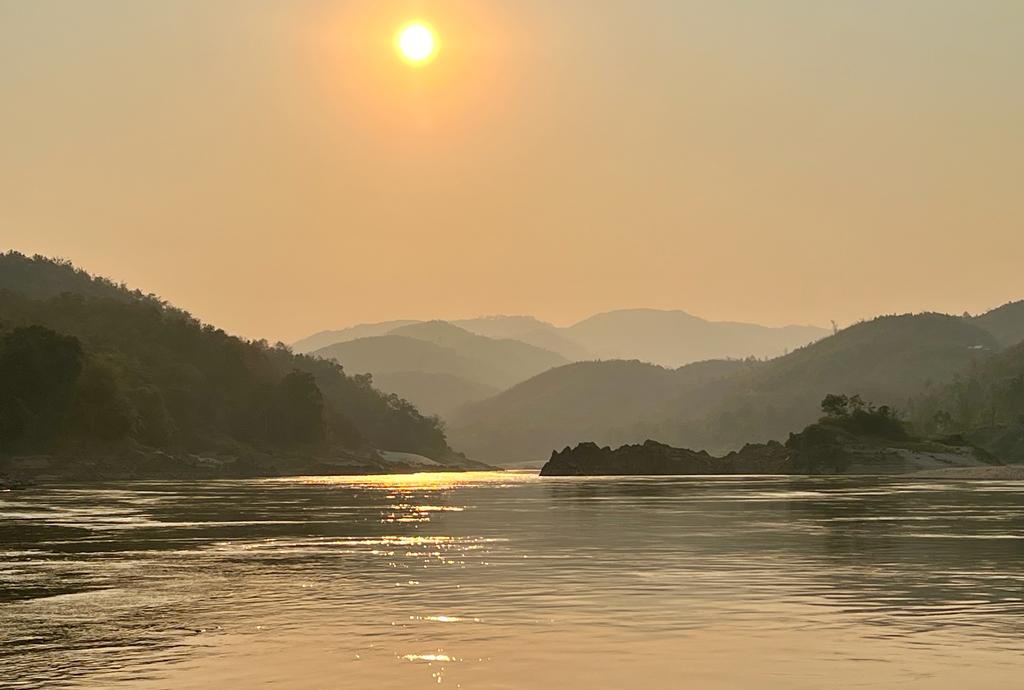
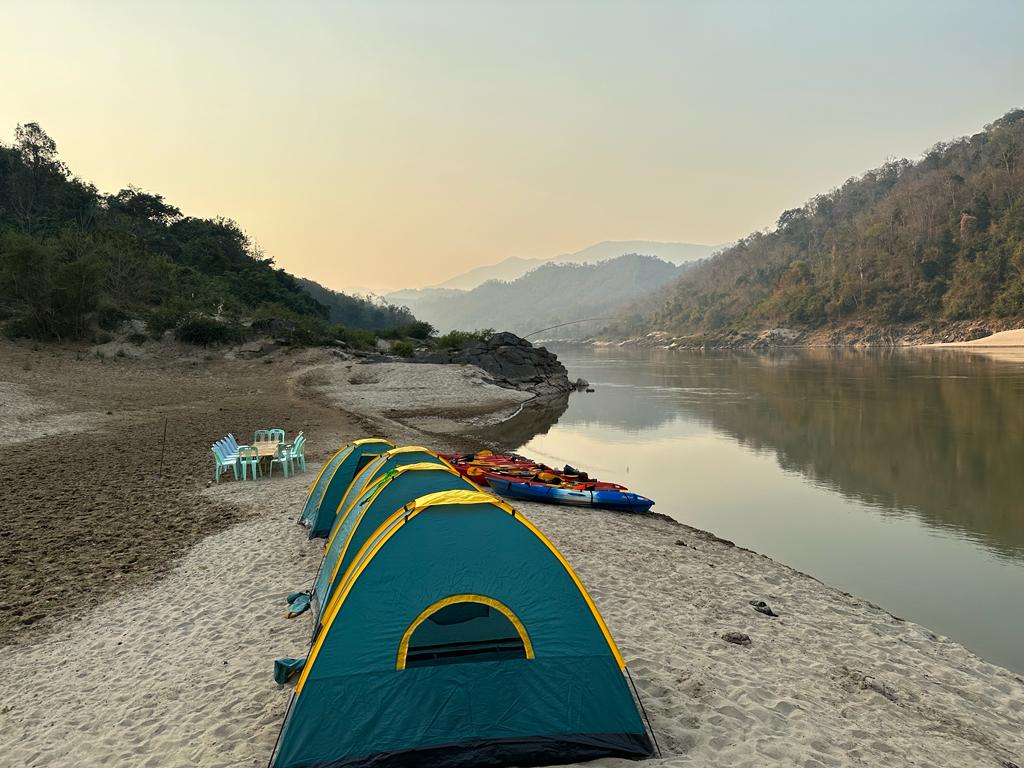
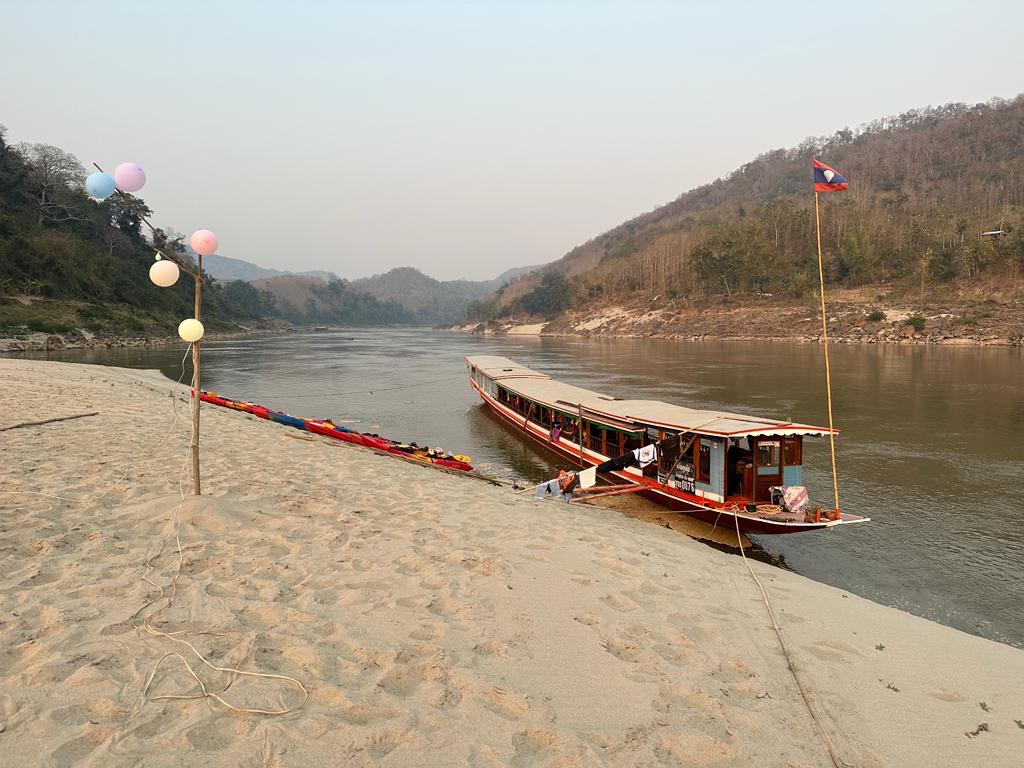
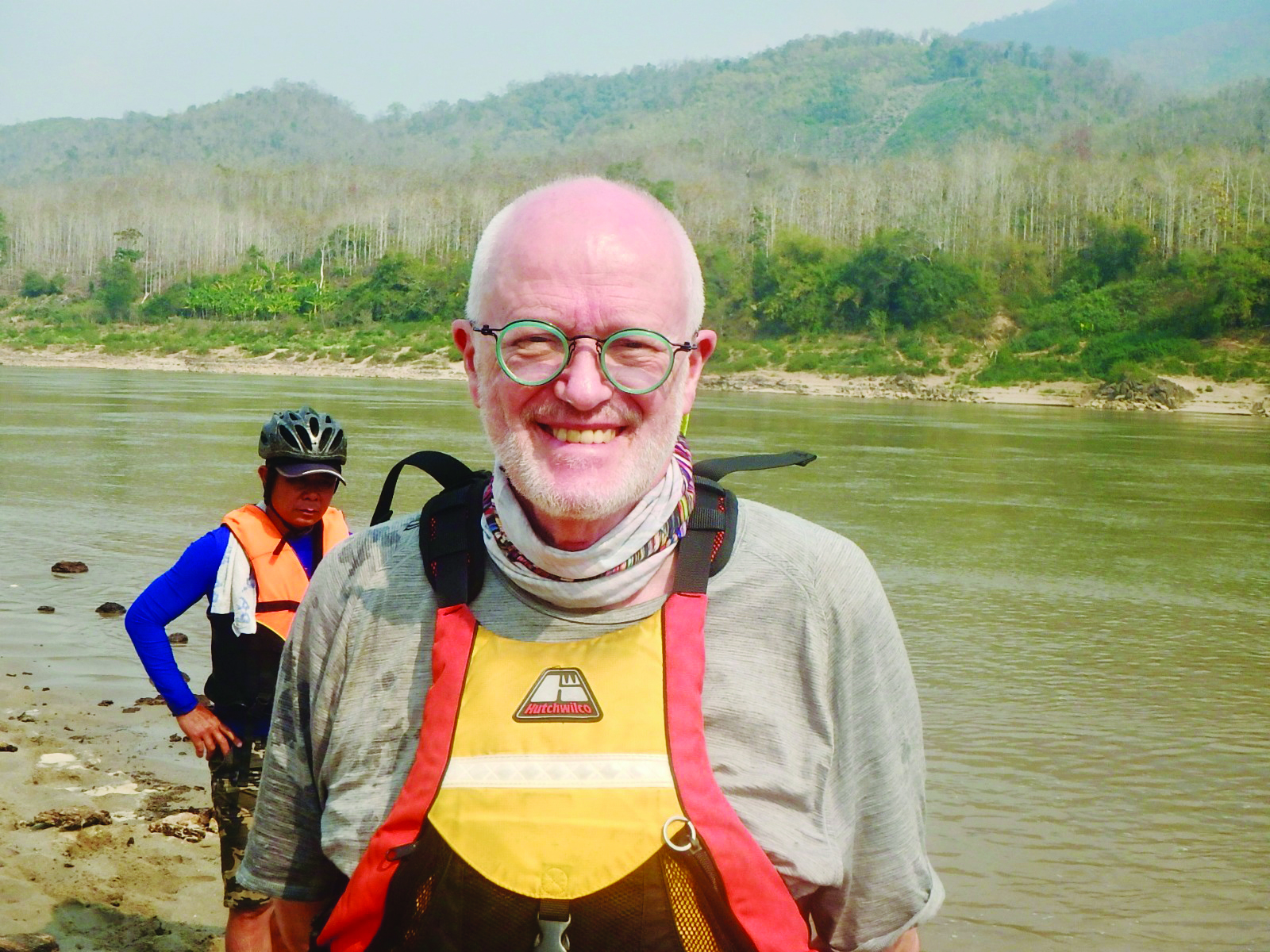
Charles had previously organised fund-raising cycling trips in the region as an active way to spread the word. He thought that a kayaking trip somewhere along the Mekong, as it ran through many of the countries A4D was helping, might attract similar interest. Charles then worked with kayaking organisers in Laos to find a route that would be challenging but doable for a group of paddlers with varying degrees of experience and not all in peak physical condition. In very quick time he had enough names to make things happen. That’s how 15 people arrived at Chiang Rai Airport on a mid-February Saturday waiting for transport to our first night stop on the Mekong.
The Chiang Khong Teak Garden hotel is a riverside guest house with views across the Mekong to Laos and was the venue for the group’s first briefing. At this point of the river it is brownish in colour, reasonably calm and flowing at about 3 to 4 kilometres per hour and not particularly inviting from a kayaking point of view. The instructions were brief: we would kayak in pairs and could expect around 30kms per day on the water. In the morning we boarded a bus to cross the Friendship Bridge into Laos and the small town of Huay Xai. Relatively painless other than the teenage girl taking the foreign currency only accepted crisp new notes and tended to forget, with the sweetest of smiles, she had just been handed notes then asking for more. From the border it was a short bus ride to the riverbank where we boarded a comfortable river taxi for the 6-hour ride to Pak Beng. Approaching the town, we saw a magnificent hotel perched at a cliff top vantage point with views both up and down river. The Le Grand Pakbeng resort was our next rest stop, We gratefully spent the evening enjoying the good food and well-stocked bar.
The kayaking group sets out from Chiangkhong, Laos
Team leader Charles, channeling his finest military days, had us on parade at first light and ready for the short bus ride to the riverbank, to meet our three kayaking guides and to be reunited with our river taxi and support boat for the five full days of paddling to Luang Prabang. Eight kayaks and sixteen paddles, plus flotation jackets and cycling helmets, were laid out neatly for all to select. Participants listened intently as we were given formal instructions of what the trip entailed. Our guides re-assured us that this was a Grade 1 river defined by those that know, as “Easy. Fast moving water with riffles and small waves. Few obstructions, all obvious and easily missed with little training.” The kayaks did not look like they were made for anything much tougher than a recreational pond, but our guides assured us they were suitable for the task. The river was wide, friendly, and flowing smoothly down stream. In the event of capsizing we were told to hang on to the kayak and wait for help if needed. We were also advised the river could get quite busy at times with river taxis and tourist boats with sometimes as many as four of five per day! And off we went. Our support boat was owned by a matronly lady named Thong Lom, ably assisted by her daughter, and expertly piloted by her husband. She had worked on the water for twenty plus years but had no recollection of anyone ever kayaking this part of the river.
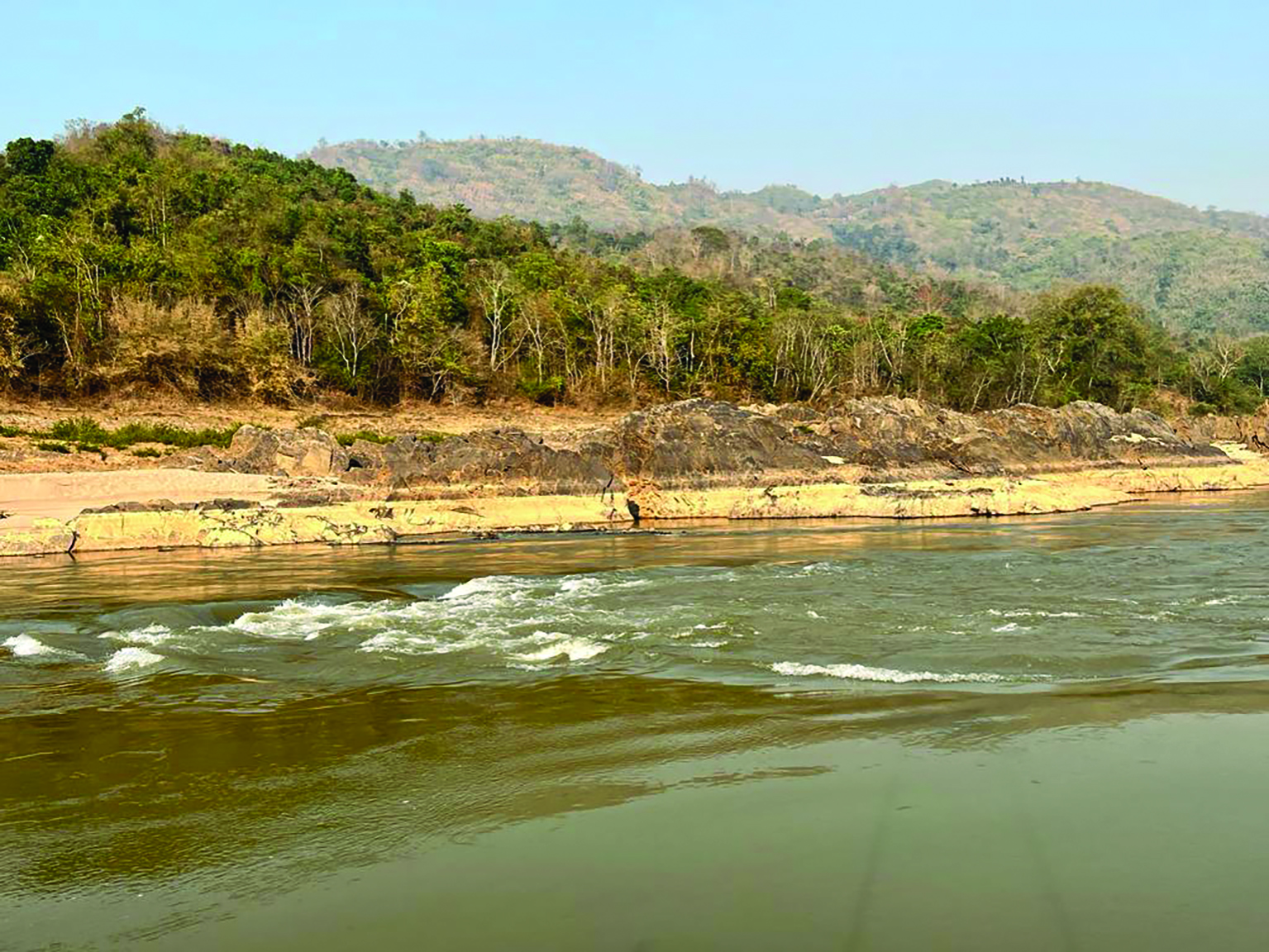
All went well for the first 30 minutes or so as we quickly began to eat up the 37kms of paddling scheduled for the day. Then in the distance we could hear the rumbling of water rushing around rocks and could see that the tranquil brown water appeared to turn white stretching across half the width. Kayaks bunched up as we got instructions to avoid any whirlpools and to follow the course set by our lead guide. “Paddle hard and paddle straight and if you do fall in hold onto your kayak.” The river narrowed and there was no option but to plough headfirst into the maelstrom. Fortunately I was sharing a kayak with the lead guide, and we powered through the 200-300 metres of turmoil in an exhilarating burst of paddles, whoops of laughter, and rocking of boat. As the river widened and the water calmed, we turned to see five kayaks upturned, some with kayakers clinging to the side and some, like a horse that had shed its jockey, majestically progressing alone. Paddlers were eventually reunited with boats and the journey continued. The rapids all had names and the second was not far away. This one was called Gaeng Huai Lao, and it boasted numerous unpredictable whirlpools in the deepest parts of the river. It too also claimed its fair share of the group with a couple of boats tipping over in the epi-centres, sucking down prey before spitting them out minus personal belongings such as shoes, eye glasses, helmets and waterproof pouches.
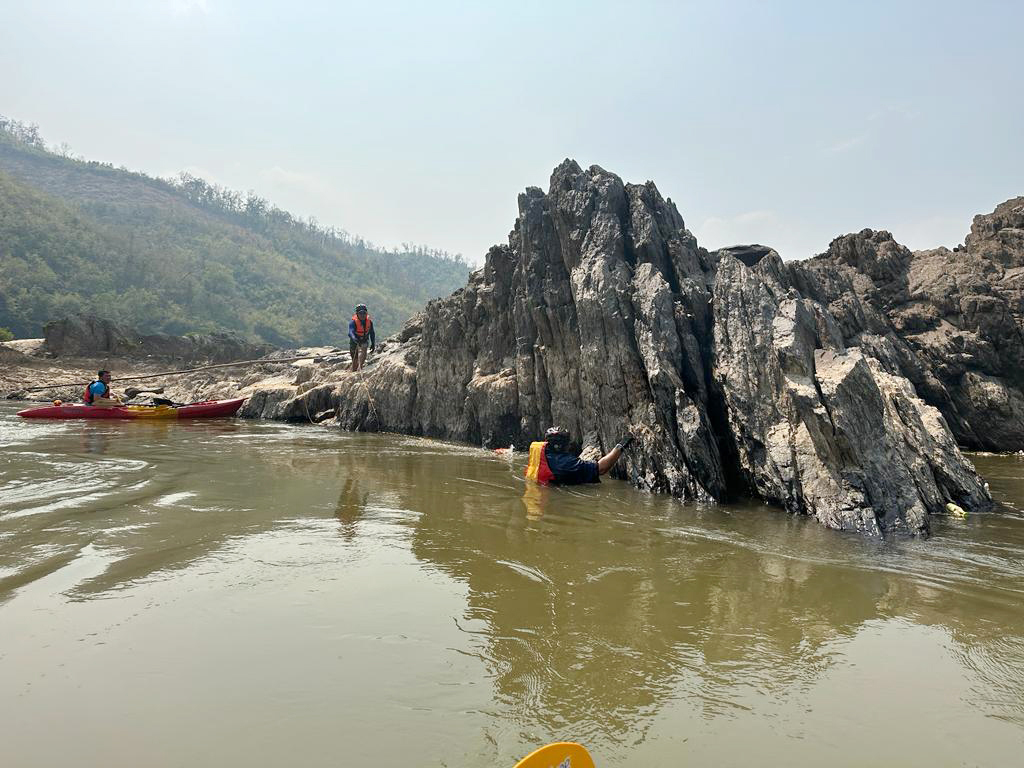
A capsized kayaker is rescued on the rocks
As the day progressed there were more rapids, rocks and whirlpools, but lessons had been learned and capsizers were quickly reunited with crafts. We had experienced “rapids with moderate, irregular waves which may be difficult to avoid and which can swamp an open kayak. Strong eddies and powerful current effects, particularly on large-volume rivers” the definition by the way of a Grade 3 river. Our first evening was spent near the village of Tanoun finding a wonderfully secluded sandy part of the river to set up camp. Boat owner Thong Lom and her daughter turned out to be superb cooks and we enjoyed the first of our five dinners around a welcome campfire as evening temperatures dipped to below 10 degrees. Beer and wine helped to keep most of the group warm.
Day Two was less eventful but a couple of kayaks tipped their cargo into the drink, as complacency crept in. On the way we pulled into a small farming village, Baan Kok Aek, and were introduced to the local Shaman who put on a show of sorts for us. Our guides re-assured us that each village has a Shaman and that over time they become very experienced at dealing with minor ailments, recognising when things look a little too serious to handle with chants, plants and wishful thinking. Village life looked quiet but there was a one-classroom primary school and the odd pick-up truck, along with motor bikes, and livestock roaming free. Then back on the kayaks to complete the 33 kms for the day before another glorious sandbank offered itself for our tents to be pitched. These sandbanks are quite unique as they are formed and then washed away on an annual basis, so we were literally the first to ever have camped at this site. A barking deer seemed less than happy to discover us in the early hours, snoring from the individual tents.
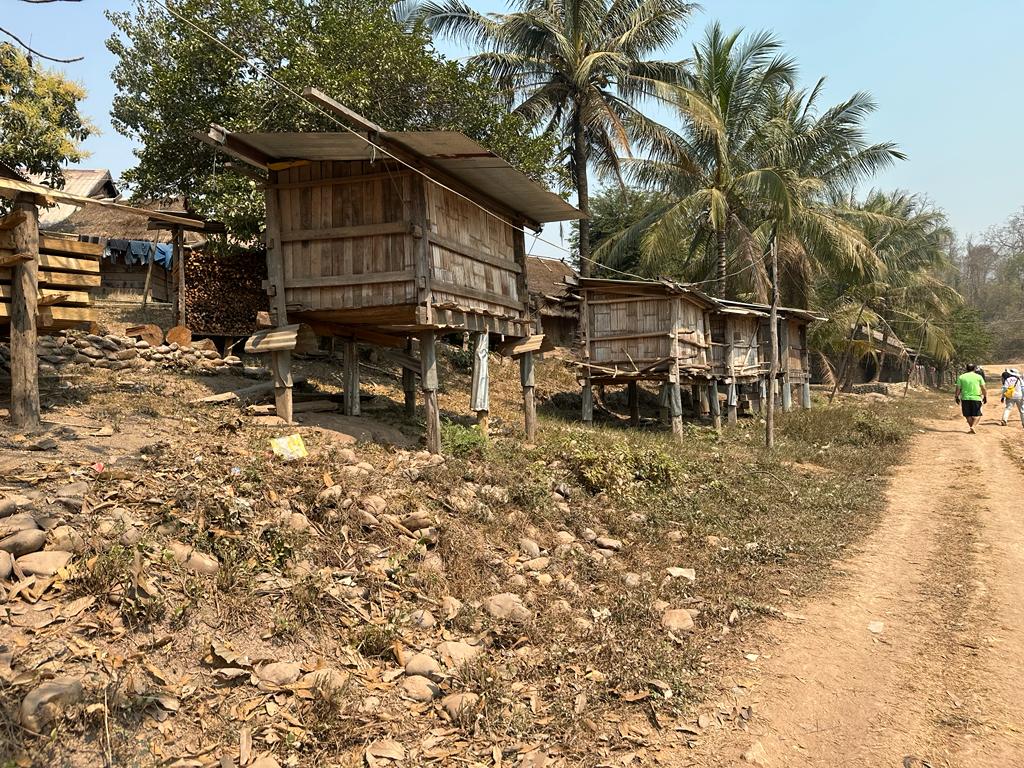
Day Three was our longest stretch on the river, celebrating our 100km marker with a group photo on the riverbank in our A4D T-shirts reminding us that in addition to the extraordinary experience we were also on a mission to raise funds to support children in Laos with Type 1 Diabetes. We also saw captive elephants being forced to slave away at their logging duties with mahouts armed with pickaxes shouting instructions. As we slowed to observe the scene a dead cow floated by overturned speeding by to its final resting place. A wild pig and her three piglets appeared on the bank inquisitive to the presence of eight kayaks. Our destination was the village of Ban Lad Kamoon, and home to Thong Lom, looking a little more prosperous than others we had passed.
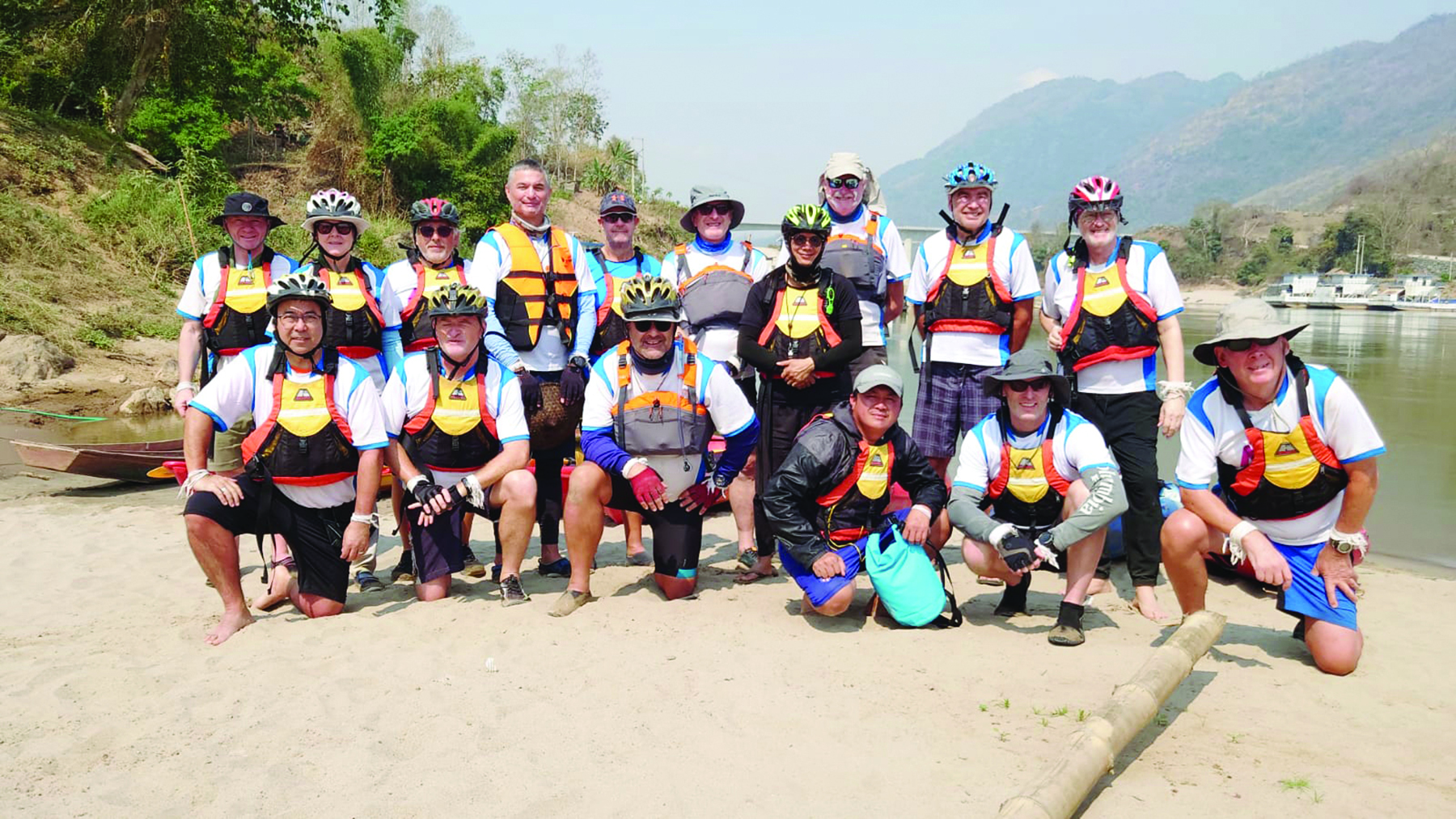
A group photo to celebrate 100 km
We were invited to a Baci ceremony in the village. These ceremonies are held to mark significant occasions. The head man of the village led the chanting and prayers after which the women elders tied white threads around the kayakers’ wrists as a blessing to bring good fortune. The village schools, primary and secondary, were both funded by overseas donors, and one of which was proudly supported by our lead guide Lang Xiang.
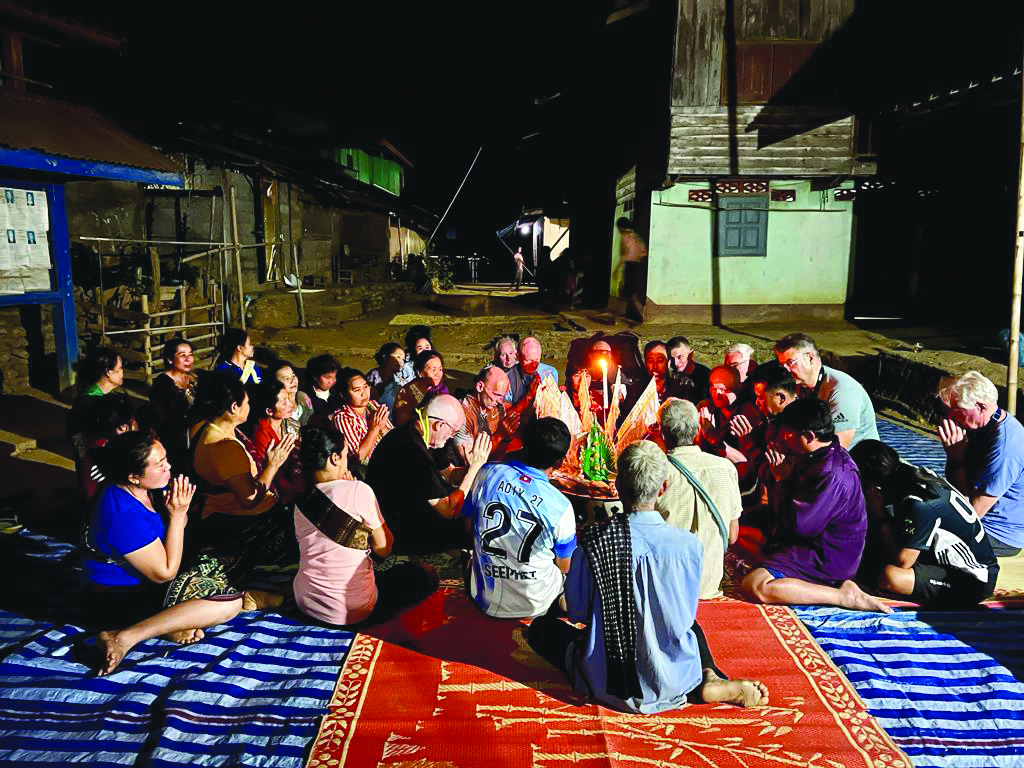
A Baci ceremony in the village
Day Four was relatively uneventful on the river. We stopped mid- journey at a “model” village Ban Hui Hai, with Khamu (translated frighteningly as real people or human beings) inhabitants. Most of the Khamu people live in the north of Laos, and many who have long made their livelihoods on this part of the Mekong face being relocated away from the river into the hills as the river becomes ever more dammed. More evidence of Chinese influence became obvious as we passed under the China-Laos railway bridge. The infrequent daily fast trains launched in 2021 transport rice and people between Yunnan and Vientiane opening up Laos to more economic exposure from China.
Life on this part of the Mekong river has hardly evolved over many centuries, but things are about to change now. The Luang Prabang Dam, now under construction 25 km downstream of this UNESCO world heritage town, will displace thousands of farming families and cause severe and detrimental damage to the lifeblood and support ecosystems created by the river system. The single-party government in Laos is intent on damming the Mekong out of the lives of those whose families have lived there for centuries, and in turning the country into a power-generating hub for the region. Thai energy businesses have happily joined the party.
As we arrived in Luang Prabang on Day Five our guides confessed that, in over twenty years of leading kayaking trips, none had ever kayaked that part of the river before. With the imminent arrival of the new dam, none will have the chance to do so in the future.
In a cinematic landscape saturated with remakes, reboots and sequels, you might ...
Find out more about your celeb favourites and their most loved vacation ...
These top 5 barber shops in Bangkok are where gentlemen can elevate ...
While traditional TV shows are serving us endless boy-meets-girl tales. Thailand has ...
Sailorr and Molly Santana’s black grills fuse hip-hop swagger with homage to ...
Netflix Thailand has officially announced a new price for base subscriptions We’ve ...
Wee use cookies to deliver your best experience on our website. By using our website, you consent to our cookies in accordance with our cookies policy and privacy policy